2.1 Preparation – 2.2 Prism experiment – 2.3 Properties – 2.4 Polarization – 2.5 Progress check – 2.6 Summary
An important objective of this basic course is to show that properties such as position and momentum cannot in general be assigned to quantum objects.
To explain this as clearly as possible, a few basic concepts are required. They include the concept of preparation which will be introduced in this lesson.
We will discuss examples which show that the preparation of properties plays an important, albeit usually unnoticed role in classical physics. The preparation of properties of physical objects is so self-evident here that it is rarely discussed in detail. In quantum physics, however, new phenomena arise which make it necessary to reconsider the concept of dynamic property anew. The discussion of the preparation concept in this lesson helps us to appreciate the new types of problems to be found in quantum physics.
If you have not already done so, please now download Chapter 2 of the teaching materials as a pdf file.
2.1 Preparation of dynamic properties in classical mechanics
The concept of preparation is introduced here using the example of the horizontal throw.
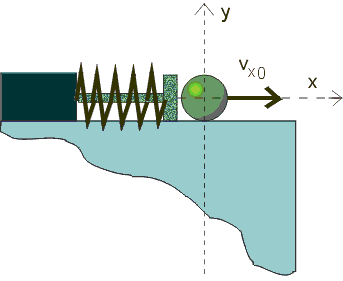
Preparation is to be understood as a method or procedure whereby objects are brought into a specific state. A preparation therefore produces physical systems with specific properties. The launch mechanism for the horizontal throw prepares balls, for example, with the two properties “is located at the launch position (![]() )” and “has the launch velocity(
)” and “has the launch velocity(![]() )”.
)”.
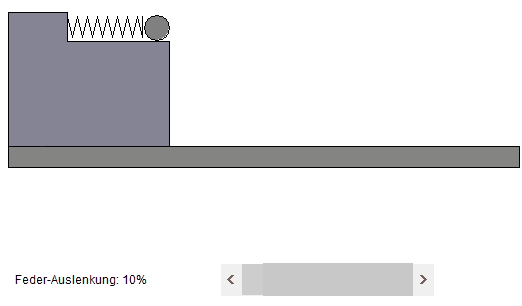
Experiment 2.1: Here you can see a well-prepared catapult. Each time you select the same spring compression, the ball will fly precisely the same distance.
In a badly prepared experiment, the measured values spread to a greater or lesser degree.
The properties produced by preparation are not fixed. They are therefore called “dynamic properties”. Conversely, the charge and rest mass of an electron are fixed, for example; these are “static properties”.
Why is so little attention focused on the concept of preparation in classical physics?
2.2 Prism experiment with light
Experiment 2.2: Selecting a narrow beam of light from the prism spectrum
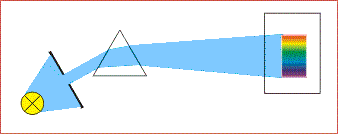
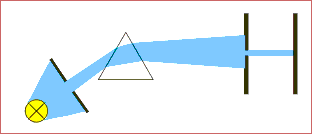
It is assumed that light of a specific color possesses a property which causes it to be refracted in the prism through a quite specific angle ![]() . This assumption can be tested as follows:
. This assumption can be tested as follows:
Experiment 2.3: The light beam selected is not dispersed again into a spectrum by a second prism. It is refracted through the same angle α as in the first prism.

The light of a specific spectral color produced in the experiment accordingly has the property “is refracted through a specific angle”. In contrast, the white light of the lamp does not have this property and is dispersed. The property found in this experiment is identical with another one: “Has a specific wavelength”. The property “wavelength” determines the angle of refraction and also the property “color”.
You can download a worksheet here.
The relationship between the concepts of preparation, test and properties can be explained as follows:
Preparation produces objects with the same initial conditions.
A test is carried out to determine whether a preparation has taken place. If the test provides an unequivocal and at the same time predictable result, then we say that the object has the corresponding property.
In quantum physics, this rule must be observed very precisely. We will find out later that there are cases in which we will arrive at a contradiction with the phenomena, when quantum objects are assigned a property without observing the rule “preparation” and “test” or “measurement”.
Necessity of preparation and test
2.3 A property is not always prepared
The semi-transparent mirror is one example for the fact that an experimental set-up does not always prepare a dynamic property, even if this initially appears to be the case. If light is incident onto a semi-transparent mirror at an angle of 45°, it is partially transmitted and partially reflected.
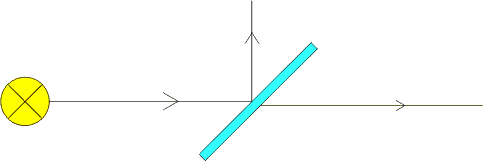
We test the transmitted part of the light for the property “is transmitted” by placing a second beam splitter into the transmitted beam.
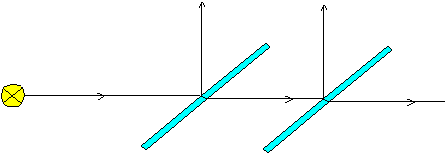
If the light had been prepared for the property “is transmitted” in the first beam splitter, then the second beam splitter would not have split up the beam again. A beam splitter therefore does not conduct such a preparation.
2.4 Polarization
We consider the property “polarization” as a further example for a preparation. To carry out the following experiments with the aid of a computer simulation, please download the “Polfilter.exe” program.
Experiment 2.4:
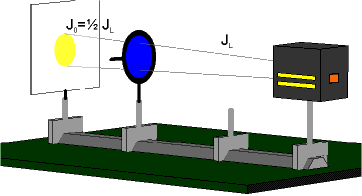
A polarization filter can polarize the light in a certain direction. This prepared property can be detected by a second polarization filter in the same position.
Experiment 2.5:
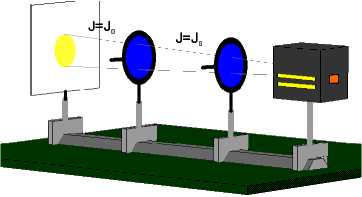
2.5 Progress check
The following points were important in this chapter:
What does preparation of a property mean?
What does test of a property mean?
Reinforce the concept of preparation with the aid of the polarization of light experiment.
Before you move on to the next chapter, make sure you know the fundamental ideas behind these points. You can then check this with the aid of the Summary.
2.6 Summary of Lesson 2: Preparation of dynamic properties
The intentional production of physical objects with specific initial conditions is called “preparation”. One example is the production of light of a quite specific color in the prism experiment with light:

The light which is prepared here has a certain property, i. e. color or wavelength. If a system is prepared for a specific property, the system exhibits this property in a test measurement (in the case above when passing through a second prism in which the light beam is not dispersed again, for example). Only when we can predict with certainty that a test confirms a specific property may we imagine that the object really does have this property.
